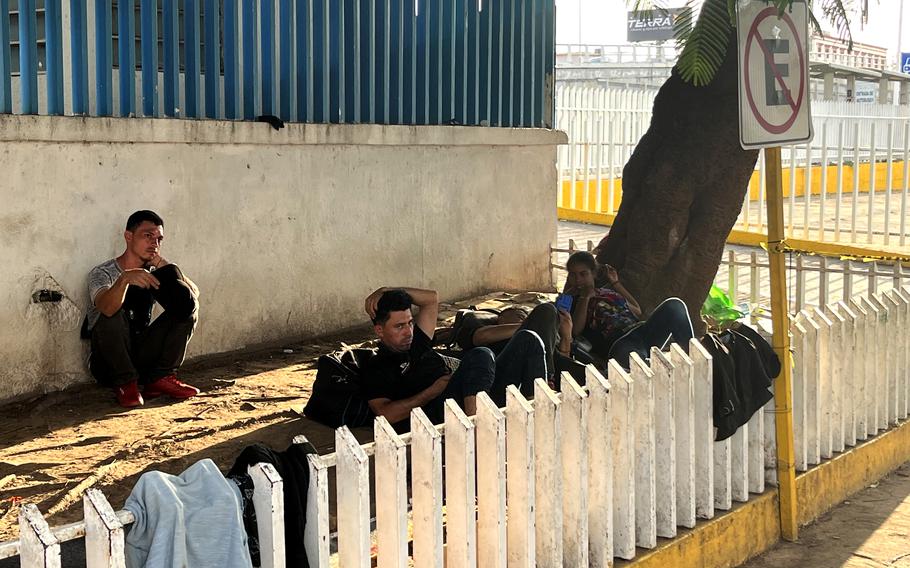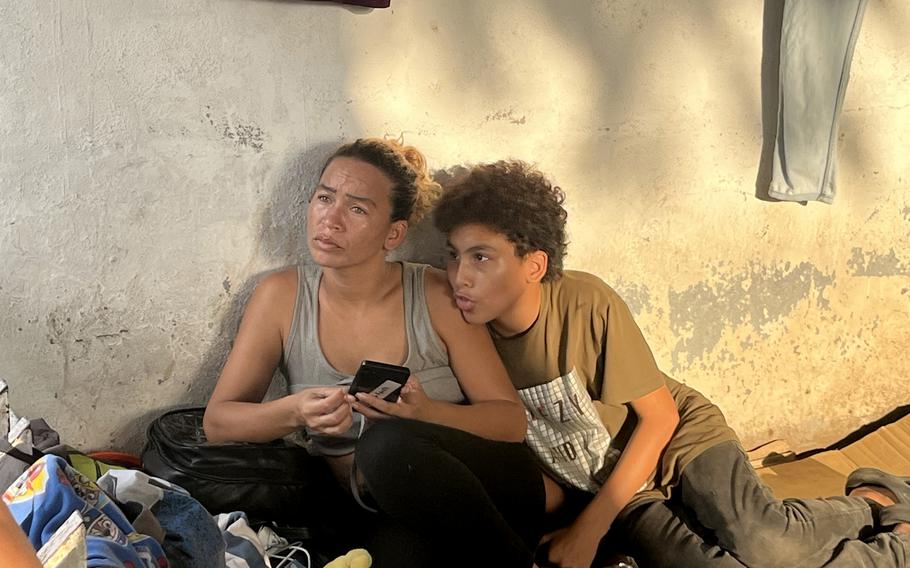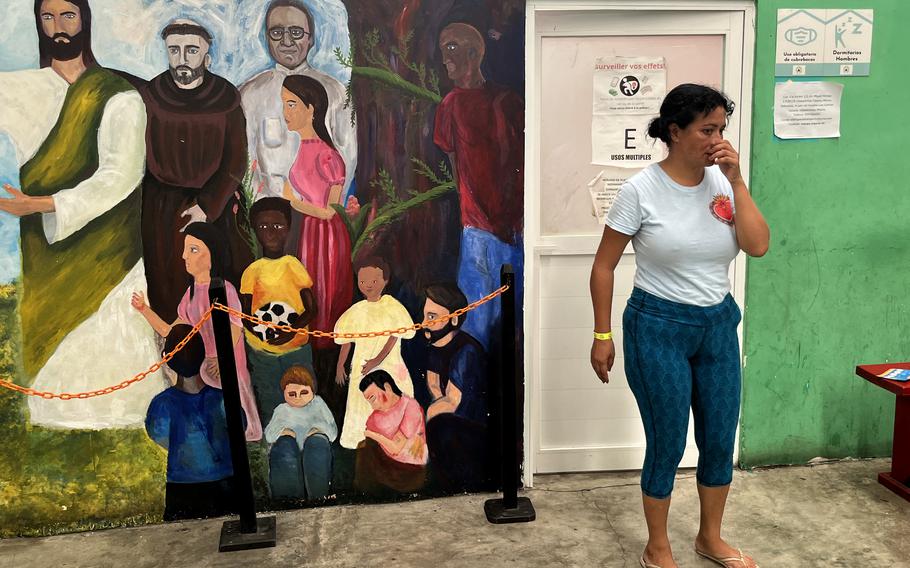
Migrants rest outside the bus station. (Mary Beth Sheridan/The Washington Post)
VILLAHERMOSA, Mexico — With detentions at the U.S. border plunging to a four-year low, everyone is angling for the credit.
Democrats highlight President Joe Biden’s tougher asylum policies. Republicans point to Gov. Greg Abbott’s razor-wire barriers on the Texas border.
But a major reason for the drop can be seen 800 miles south of the border in this sleepy, palm-shaded city closer to Guatemala than to the United States. Here, sleek white government buses roll in, one after another, to disgorge groups of bewildered migrants.
The foreigners have been stopped at highway checkpoints or plucked from buses and trains, caught in a massive dragnet set up by Mexico under U.S. pressure. But the government can’t afford to deport them. So it sends them back here to southern Mexico — where many simply turn around and head north again.
Officials call it “El Carrusel.” The merry-go-round.

Yoleida Aponte, 34, a Venezuelan migrant, rests with her son at an encampment outside the Villahermosa bus station. The family was detained in central Mexico and bused back to the south. They intend to head north again. (Mary Beth Sheridan/The Washington Post)
The tactic isn’t totally new, but is being employed more aggressively than ever before. Since the start of this year, the Mexican government has bused around 10,000 migrants a month to the south, roughly double the figure last year, according to official data obtained by the migrant activist Gretchen Kuhner. Thousands more captured migrants are loaded onto planes or minibuses for the trip.
Senior U.S. officials and migrant advocates say the operation is a major factor in the stunning fall in apprehensions at the U.S. border, down 77 percent since December.
But it’s unclear whether the results are sustainable. The number of migrants camped out in Mexican cities is rising. And advocates and aid workers worry about the human toll.
“I call it the policy of wearing people out,” said Eunice Rendón, head of the nonprofit advocacy group Agenda Migrante.
María Rosa Barrios, 33, a Venezuelan X-ray technician, is stuck on the carousel. She entered Mexico with her partner and their three sons in February. Now they were at a migrant shelter in Villahermosa. “This is our fourth time trying to go north,” she said.
The family was first picked up by immigration agents outside the northern city of Monterrey in March and bused to southern Chiapas state. In May, they were ordered off a train near Piedras Negras, across from Eagle Pass, Tex., and returned again. In August, they were stopped just hours after setting out from Chiapas.
By now, Barrios’s dyed blonde hair has gone dark. She’s dropped two pants sizes for want of food. Her skin, once the color of almond milk, is now rough and browned by the sun.
Round and round she goes.
“Sometimes I say, why did I make this decision?” she said. Tears welled in her eyes. “But I have to continue, to help my parents, to help my children.”

María Rosa Barrios, 33, comforts her 4-year-old son, José, in a blue T-shirt, as her 9-year-old son, Crhistian, looks away at the Amparito shelter for migrants in Villahermosa, Mexico. Barrios is hoping to reach the United States to earn money to pay for treatment for Crhistian’s growth disorder. (Mary Beth Sheridan/The Washington Post)
Mexico triples its migrant detentions
Mexico launched the crackdown just after Secretary of State Antony Blinken led a delegation to Mexico City in December. Record numbers of migrants were reaching the U.S. southern border and Republicans were pounding Biden on the issue ahead of the presidential election. Blinken pressed President Andrés Manuel López Obrador to step up enforcement, according to U.S. and Mexican officials.
Mexico’s migration agency went into overdrive. Aided by the military, agents added checkpoints on highways and ramped up searches of trains and buses. In the first half of 2024, Mexico logged 712,226 apprehensions — nearly triple the number in the same period last year.
Mexico couldn’t possibly deport that many people. It wasn’t just a question of money. Its Supreme Court had ruled that migrants could be detained for only 36 hours, not enough time to process most for a return home. So authorities dramatically scaled up a program to send them to cities near the Guatemalan border.
The merry-go-round is just one of the government’s tactics. Authorities also tightened access to humanitarian visas, which many migrants were requesting under the guise of seeking asylum in Mexico but using instead to travel to the U.S. border. Officials leaned on railway operators to keep migrants from hopping freight trains.
Those detained are being sent to southern cities that are often ill-equipped to handle them. Villahermosa’s only migrant shelter, known as Amparito, is hosting twice as many migrants as a year ago. When the 60 beds in its dorm-style rooms fill up, the staff squeeze mattresses into the main meeting room and the children’s play area.
“An infrastructure with 60, 90, 100 beds isn’t remotely enough for the number of people who come,” director Karina Vidal said.

Barrios outside her dormitory-style room at the shelter. (Mary Beth Sheridan/The Washington Post)
Mexican policy leaves migrants in a state of ‘helplessness’
Barrios’s case shows why migrants continue to push two, three or four times to get through Mexico to the United States.
The economy in her native Venezuela has collapsed, the result of mismanagement by the socialist government and punishing U.S. sanctions. Nearly 8 million people have fled. Barrios and her partner, Mario, a taxi driver, couldn’t make ends meet. And they were growing increasingly anxious about their 9-year-old son, Crhistian.
At the shelter, Barrios watched Crhistian skip off to play with his 4-year-old brother. They were the same size. “The treatment he needs is very expensive,” she said. There was no way to earn enough in Venezuela to deal with his growth disorder.
Barrios left Venezuela in January with her Bible and “a suitcase of dreams.” The family hiked through the treacherous Darién Gap, the 60-mile stretch of jungle between Colombia and Panama, and worked their way to Mexico by bus and on foot.
Eight months later, they’re broke. Like other migrants who cluster at stoplights or on street corners in Villahermosa, the family peddles lollipops or begs for change outside convenience stores. They’re often reduced to sleeping in the street.
“We use our shoes for pillows,” Barrios said.

Migrants at the shelter choose from a pile of donated shoes. (Mary Beth Sheridan/The Washington Post)
She’s adopted a determined cheerfulness. There’s no going back to Venezuela; she’s sold her house. And, she figures, other Venezuelans made it to the United States. Why can’t they? She keeps her kids going with stories of life in America.
“They ask, ‘Mama, when will we reach the beautiful country? When will you take me to Disney?’” Barrios said.
Analysts say the merry-go-round is subjecting vulnerable people to horrific conditions, including kidnapping and robbery by criminal groups. Many migrants are escaping life-threatening violence or economic collapse back home, said Tonatiuh Guillén, a former head of Mexico’s migration agency. “These aren’t the migrants of years ago.”
Mexico denies it’s being cruel; it accepted a record 140,000 applications to its own refugee program in 2023. But the figure has plunged this year, as officials try to crack down on abuse. Aid workers fear it’s becoming harder to access the system.
Biden is also taking measures to control migration
Andrew Selee, president of the nonpartisan Migration Policy Institute in Washington, has been watching detentions fall at the U.S. border. “I keep saying it’s not sustainable,” he said. “And then they sustain it.”
That’s due not just to the Mexican merry-go-round. The Biden administration has steadily ratcheted up penalties for asylum seekers who arrive illegally. Texas officials claim credit for Operation Lone Star — a three-year-old program that’s fortified the border with razor wire, National Guard and police. Analysts, however, note that other states have recorded similar drops in border-crossers without such measures.
Some migrants may have postponed their trips because of the cooling U.S. job market, or an effort by Panama to curtail traffic through the Darién Gap.
“This is all happening at the same time,” said Selee. “It may have created enough reinforcing factors to keep the numbers down for a bit.”
The Mexican government is hoping that the combination of U.S. policies and its own enforcement will transform the dynamics at the U.S. border. Around 75,000 migrants a month are now entering the United States through legal channels — many using an app called CBP One to schedule appointments for asylum interviews.
Washington recently made the app available in the southern Mexican states that border Guatemala in addition to those in the central and northern parts of the country. Mexico has promised to begin transporting those in the south who have appointments to the U.S. border. “We believe that guaranteeing safe migration is part of our job,” Foreign Minister Alicia Bárcena said.
But only around 1,450 appointments are available each day through CBP One, far less than the number of migrants seeking them. Many people struggle for weeks to get a date via the app — and when they do, it’s often several months in the future, leaving them waiting in Mexico.
Other factors could foil the efforts to keep border arrivals down. Smugglers typically find ways around enforcement measures. A new wave of Venezuelans could reach the United States in the wake of the country’s July presidential election, which was widely denounced as fraudulent.
“It’s not easy,” Barrios said. “But it’s also not impossible.”
Video: The Mexican Government is routinely bussing immigrants to their southern states before they can reach the U.S. border.
Valentina Muñoz Castillo in Mexico City contributed to this report.
(c) 2024, The Washington Post.